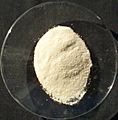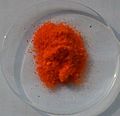Cerium facts for kids
Cerium is a special kind of element that has the atomic number 58. This number tells us that every atom of cerium has 58 protons in its center, called the nucleus. Cerium's chemical symbol is Ce, and it belongs to a group of elements known as lanthanides. Its average atomic mass is about 140.12.
Contents
What is Cerium Like?
Cerium is a shiny, grey metal. At normal room temperature, it is a solid. If you heat it up to 798 degrees Celsius (1468 degrees Fahrenheit), it melts into a liquid. It boils and turns into a gas at a very high temperature of 3424 degrees Celsius (6195 degrees Fahrenheit).
Cerium is quite common on Earth! About 0.0046% of the Earth's crust is made of cerium. That's more than elements like Tin and Lead, and almost as much as zinc. When cerium is exposed to air, it burns and forms a compound with one cerium atom and two oxygen atoms.
How Was Cerium Found?
Scientists first discovered cerium in 1803. It was found in Sweden by two scientists, Berzelius and Hisinger. Around the same time, Klaproth also found it in Germany. Because cerium reacts easily with other things, it was hard to get it in its pure metal form. It wasn't until 1875 that pure cerium was finally made in Washington DC.
Cerium got its name from the asteroid or small planet called Ceres. This asteroid was first spotted just two years before cerium was discovered, in 1801.
What is Cerium Used For?
You don't often see cerium used as a pure metal because it reacts quickly with air and loses its shine. However, it has some very interesting uses!
One of its most common jobs is being the 'flint' in a lighter. When you strike it with another metal, it easily creates a spark, which is perfect for lighting things. Cerium is also sometimes added to alloys (mixtures of metals) because it can make them more resistant to heat. You can also find cerium in special kinds of glass, ceramics, and even in self-cleaning ovens!
Different Forms of Cerium
Cerium can react in two main ways to form different types of compounds. These are called cerous compounds or salts, and ceric compounds. In cerous compounds, cerium acts with an oxidation number of 3, and in ceric compounds, it acts with an oxidation number of 4. This number tells us how many chemical bonds cerium likes to form.
Cerium's Family Members: Isotopes
Like many elements, cerium has different versions called isotopes. These isotopes are all cerium atoms, meaning they all have 58 protons. But they have different numbers of neutrons in their nucleus, which makes them slightly different weights.
Four of cerium's isotopes are found naturally:
- Cerium-136: This isotope has 58 protons and 78 neutrons. It is slightly radioactive, meaning it slowly changes over time.
- Cerium-138: This one has 58 protons and 80 neutrons and is stable, meaning it doesn't change.
- Cerium-140: With 58 protons and 82 neutrons, this is the most common isotope, making up about 88.5% of all cerium. It is also stable.
- Cerium-142: This isotope has 58 protons and 84 neutrons and is also radioactive. It makes up about 11.1% of all cerium.
The average weight of all these isotopes is what gives cerium its atomic mass of 140.12.
Related pages
| Periodic table | |||||||||||||||||||||||||||||||||||||||||
|---|---|---|---|---|---|---|---|---|---|---|---|---|---|---|---|---|---|---|---|---|---|---|---|---|---|---|---|---|---|---|---|---|---|---|---|---|---|---|---|---|---|
| H | He | ||||||||||||||||||||||||||||||||||||||||
| Li | Be | B | C | N | O | F | Ne | ||||||||||||||||||||||||||||||||||
| Na | Mg | Al | Si | P | S | Cl | Ar | ||||||||||||||||||||||||||||||||||
| K | Ca | Sc | Ti | V | Cr | Mn | Fe | Co | Ni | Cu | Zn | Ga | Ge | As | Se | Br | Kr | ||||||||||||||||||||||||
| Rb | Sr | Y | Zr | Nb | Mo | Tc | Ru | Rh | Pd | Ag | Cd | In | Sn | Sb | Te | I | Xe | ||||||||||||||||||||||||
| Cs | Ba | La | Ce | Pr | Nd | Pm | Sm | Eu | Gd | Tb | Dy | Ho | Er | Tm | Yb | Lu | Hf | Ta | W | Re | Os | Ir | Pt | Au | Hg | Tl | Pb | Bi | Po | At | Rn | ||||||||||
| Fr | Ra | Ac | Th | Pa | U | Np | Pu | Am | Cm | Bk | Cf | Es | Fm | Md | No | Lr | Rf | Db | Sg | Bh | Hs | Mt | Ds | Rg | Cn | Uut | Fl | Uup | Lv | Uus | Uuo | ||||||||||
|
|||||||||||||||||||||||||||||||||||||||||
Images for kids
-
The dwarf planet and asteroid Ceres, after which cerium is named.
See also
 In Spanish: Cerio para niños
In Spanish: Cerio para niños









